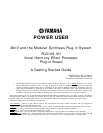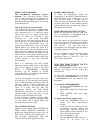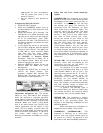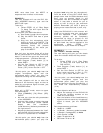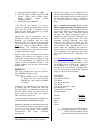
MIDI note data from the MOTIF or
sequencer has no effect in this mode.
EXAMPLE 1
This first example will use the PLG 100-
VH’s VOCODER Harmony type and the
MOTIF A/D Input.
To do this:
• Follow STEPS 1-3 of “Easy Steps
To Using The A/D Input and the
PLG 100-VH”.
At this point, you should be able to:
a) Hear audio through the microphone
b) Play the MOTIF and hear a piano
Voice.
c) Sing into the microphone while
playing a chord on the MOTIF. The
harmonies produced (up to three
harmony notes) are pitches
corresponding to the notes you
play on the MOTIF.
Now let’s turn the piano Voice off so that
we can concentrate on the Vocal Harmony
board. To do this we go to the lower level
of edit parameters – individual Part edit.
• Push Program (Track) button [1] to
select PART 1
• Set the Part Switch to OFF for the
piano voice currently in Part 1. [F1]
Voice / [SF1] Voice. Part Sw = OFF
*At this point, you should only hear the
original microphone signal and the
harmonized parts (when you play the
keyboard and sing into the microphone).
The next objective will be to alter the
balance of the harmony signal so that no
actual dry microphone signal is heard, just
the VOCODER effect.
While still in EDIT mode, return to upper
level parameters:
• Press [COMMON]/ [F6] Effect/ [SF2]
PLG-EF.
• We now can view the edit parameters
of the VOCODER.
• Use the right cursor to select the page
with the LowerG.Dpt (Lower Gender
Depth) and the Lead/Harm
(Lead/Harmony) balance parameters in
the right column.
• Adjusts the balance between the “lead”
and the PLG 100-VH’s vocal harmonies.
• Set the L=H parameter to “L<H63”
*At this point, you should only hear the
harmonized parts (when you play the
keyboard and sing into the microphone).
Don’t be afraid to sing OUT LOUD. Many
people never hear the effect because they
don’t give up enough signal to the
microphone. But don’t overload the signal
either. It may take a minute for you to
adjust to how to sing to get maximum
benefit. Remember you have 3 parts so
playing more notes than that is, well, silly.
Using the PLG100-VH in this manner will
allow you to actually play your vocal parts
from the keyboard. The “synthesizer”
harmony pitches will be completely
determined by what is played on the
keyboard of the MOTIF. Controllers such
as pitch bend can also be applied to the
harmonized effect. STORE this
Performance, if you would like to keep it.
_________________________
EXAMPLE 2
the “Classic” Vocoder setting
The next setting will give you the classic
robot-like vocoder effect with key control.
To do this:
• Follow STEPS 1-3 of “Easy Steps
To Using The A/D Input and the
PLG 100-VH”.
• Push Program (Track) button [1] to
select PART 1
• Set the Part Switch to OFF for the
piano voice currently in Part 1. [F1]
Voice / [SF1] Voice. Part Sw = OFF
*At this point, you should only hear the
original microphone signal and the
harmonized parts (when you play the
keyboard and sing into the microphone). If
not, check the Lead/Harmony balance
(L=H).
The next objective will be to:
• Adjust the settings of the PLG100-VH
to put the finishing touches on the
robot-like voice effect.
• Alter the balance of the Lead/Harmony
signal so that no actual dry microphone
signal is heard, just the VOCODER
effect.
Set the parameters as follows:
• ‘Mode’ to –1 OCT
• ‘H.Gender’ (Harmony gender)to auto
• ‘L.Gender’ (Lead gender) to male
• ‘Pitch Correct’ to ON
• Upper Threshold to “5”
• Set Lower Thrsh to “6”.



